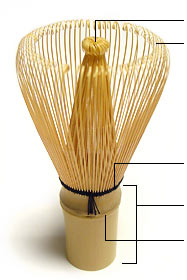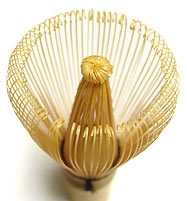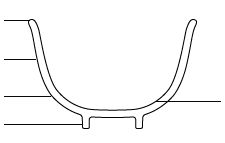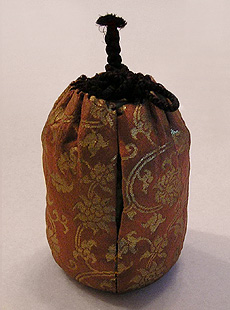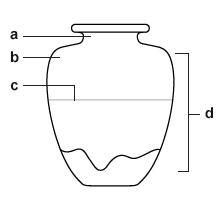| ||||||||||||||||||||
| chanoyu 茶湯 | ||||||||||||||||||||
| Lit. the hot water for tea. Also known as sadou 茶道 or chadou. The ritual art of preparing and drinking green tea. Chanoyu has been an integral part of Japanese culture since the 15c, an important well-spring of native aesthetics, and a major inspiration for the development of new styles of ceramics, architecture, garden design, decorative arts and painting. Chanoyu has also been a dominant force in connoisseurship and collecting, and has come to be closely linked with the aesthetic concepts of, simple taste wabi わび and suki 数寄. Tea drinking originated in China where it was associated with pharmacology and Daoist beliefs in alchemy and immortality. Lu Yu's 陸羽 (d.804) Treatise on Tea (Ch: Chajing, Jp: CHAKEI 茶系, trans. F.R.Carpenter, The Classic of Tea, Boston, Little Brown, 1974) outlined the many virtues of tea as well as explaining its history, the proper method of preparation and the attendant aesthetic of drinking it. Although compressed tea dancha 団茶 was drunk in Japan for medical purposes since the Nara period (8c), it was in the 9c that courtiers drank tea during social gatherings and priests drank it at the conclusion of sutra readings ceremonies. In the late 11c the priest Joujin 成尋 (1011-81) brought back tea bowls *chawan 茶碗 from Song dynasty China, and shortly after that the first powdered tea matcha 抹茶 was imported. The priest Eisai 栄西 (1141-1215), after studying in China, returned to Japan with a new enthusiasm for tea drinking as an adjunct to Buddhist practice. In addition to planting tea, Eisai wrote KISSA YOUJOUKI 喫茶養生記 in 1214, propagating the practice of tea because it preserves health, sharpens the mind, promotes ethical behavior, and leads to spiritual understanding. The book also explains the etiquette of tea preparation and drinking as Eisai learned it in China. Although tea drinking was formalized as monastic practice in some Zen 禅 temples, reportedly as an aid against drowsiness during meditation, by the first-half of the 14c the aesthetic dimensions of tea began to emerge. The expansion in tea drinking was facilitated by tea gatherings chayoriai 茶寄合 in which the participants would attempt to distinguish the provenance of different teas based on taste and aroma. These tea-guessing contests, or toucha 闘茶, were usually part of extravagant parties that featured alcohol, banqueting, music, dance, and poetry composition. The extravagant nature of these affairs earned them the name basara 婆裟羅, from the Sanshrit vajra or "diamond," implying excess. Basara style tea gatherings featured the conspicuous display of Japanese and particularly Chinese treasures karamono 唐物 (Literally "Chinese things." The term is especially common in chanoyu 茶湯 to designate paintings, ceramics, lacquerware, textiles and other crafts, but has been used in a variety of contexts since the 8c. The appeal of karamono, as distinct from wamono 和物 or Japanese objects, is rooted in a fascination with the exoticism and prestige of Chinese culture. However, many karamono were not produced in China but came from Korea or other regions. Reverence for karamono is often associated with Ashikaga Yoshimasa 足利義政 (1436-90) whose collection of them was unsurpassed.) in the formal reception rooms zashiki 座敷. The decoration of the zashiki, called zashikikazari 座敷飾 is illustrated in several painted handscrolls emaki 絵巻 of the period such as Boki-e 幕帰絵 (1351, Nishihonganji 西本願寺, Kyoto). The need for a room to hold literary and artistic gatherings led to the development of the 'gathering room' kaisho 会所. The taste for Chinese artifacts fueled trade with Ming China and engendered the conspicuous collecting of Chinese and Korean ceramics and lacquer, particularly Song dynasty tenmoku 天目 (Ch: tianmu) tea bowls tenmoku jawan 天目茶碗, as well as Song and Yuan paintings sougenga 宋元画 by artists such as Muqi 牧谿 (Jp: Mokkei, late 13c) and Liang Kai 梁楷 (Jp: Ryo Kai, early 13c). The basara type of tea party reached its height in the Kitayama cultural era Kitayama bunka 北山文化. The large number of Chinese articles that flowed into Japan for display on the tea-utensil stand daisu 台子 brought about the need to authenticate genuine works. During the Higashiyama epoch Higashiyama bunka 東山文化 connoisseurs known as douboushuu 同朋衆 (A title of artistic or cultural advisors in the Ashikaga 足利 shogunate, established about the time of Yosimitsu 義満 (r.1358-1408). At first the douboushuu were attendants in charge of miscellaneous personal affairs for the shoguns, but they became cultural advisors to the Ashikaga household as well. Duties included acting as curators of Chinese paintings and objects in the shogunal collections, and as experts on the repair and authentication of works of art. In addition, many of them displayed various talents, such as painting, and acting as masters of noh 能 and kyougen 狂言 drama, the incense ceremony, poetry writing, flower arrangement, various crafts, and garden design. The Chinese characters for "ami" 阿弥, from the name of the Buddha Amida 阿弥陀, are found quite frequently among the names of douboushuu indicating a connection with the Jishuu 時宗 Buddhist sect (although it would be incorrect to say that all douboushuu were adherents of the sect.) The social status of the douboushuu was not particularly high, and among their ranks were some who were referred to as kawaramono 河原者 ("riverbed people", or "riverbank riffraff"). This derogatory term referred not only to outcasts and beggars but also actors and other entertainers, all of whom belonged to a landless segment of society on which no taxes were levied. They adopted the guise of a buddhist monk by becoming a priest, they were exempt from the caste system. Thus the douboushuu were seen as outside the strict heirarchy of rank based on birth and they could gain uniquely privilaged access and influence in the upper reaches of society. Among the early Ami artists, the master garden-designer Zen'ami 善阿弥 (1393-?) who served under Yoshimasa 義政 (1435-90) seems to have come from such a background. Ryuuami 立阿弥 the flower-arranger, and Chouami (?), the craftsman were also early Ami artists. In addition, three generations of painters and connoisseurs of art known in modern times as the Ami school (Amiha 阿弥派) provided a new direction for development in Japanese ink painting during the late 16c and early 17c. In the Edo period the douboushuu had certain advisory and miscellaneous duties in service to the bakufu 幕府 government and various major daimyou 大名, but did not hold the influential positions which they had enjoyed during the earlier shogunate.) decided on the proper arrangement of tea wares and made catalogs of famous collections, such as the GYOMOTSU ON-E MOKUOKU 御物御画目録. The "taste for Chinese treasures" karamono suki 唐物数奇 also led to their copy by Japanese artists, stimulating domestic ceramic and painting production. Chanoyu of the Higashiyama period also engendered a new environment for its drinking: the shoin 書院, a room fitted with tatami 畳 mats, a decorative alcove tokonoma 床間, staggered shelves chigaidana 違い棚, and built-in table tsukeshoin 付書院. The Doujinsai 同仁斎 shoin built for Ashikaga Yoshimasa 足利義政(1436-90) in the Tougudou 東求堂 at his Higashiyama retreat in 1486 is considered the prototype of the shoin. The last decades of the 15c saw the further development of chanoyu away from basara practices as the tea master Murata Jukou 村田珠光 (1422-1502) sought to integrate the taste for Chinese articles with the appreciation of more rustic native wares. This finding of beauty in things simple, austere, irregular and imperfect, was termed wabi. Jukou's follower Murata Souju 村田宗珠, who held his tea gatherings in a small thatched hermitage *souan 草庵 in the center of Kyoto, created a new taste that was soon adopted by wealthy merchants in the port of Sakai 堺. Takeno Jouou 武野紹鴎 (1502-55), originally a practioner of Japanese linked verse, renga 連歌, extended the concept of wabi along the ideals of eremitism long expressed in medieval literature by reducing his souan tea room to four and a half mats yojouhan 四畳半 and leaving many of the building materials in their natural state. Wabicha わび茶 or "wabi-style tea" reached its apogee in the late creations of another Sakai merchant, Sen Rikyuu 千利休 (1522-91), who eventually served as tea master and confidant to the shogun 将軍, Toyotomi Hideyoshi 豊臣秀吉 (1536-98). Rikyuu used his position to champion wabicha, further reducing the souan in size and decor, patronizing new types of native ceramics such as rakuyaki楽焼, and making other kinds of tea implements out of unfinished bamboo. Rikyuu also added a spiritual aspect to chanoyu, linking the practice of chanoyu with the practice of Zen. In the Momoyama period chanoyu became increasingly popular with powerful military patrons, serving as proof of their cultural hegemony, a locus for political deal-making, and as an artistic retreat from a brutalized society. Furuta Oribe 古田織部 (1544-1615), a disciple of Rikyuu altered the direction of chanoyu, expanding the size of the souan, adding subsidiary rooms kusari-no-ma 鎖の間 so it resembled a shoin, and utilizing new tea wares regarded as oddities hyougemono ヒョウゲモノ because of their bold designs and assymetrical, unique, shapes. Oribe also employed foreign (nanban 南蛮) designs and objects, adding to the heterdox and radical character of his aesthetic. Often called daimyoucha 大名茶 because of its supposed popularity among military patrons, Oribe's taste more accurately reflects the highly mannered spirit of the early 17c, epitomized by the word kabuku かぶく meaning "not to stand straight." The next major development in chanoyu was affected by Oribe's disciple Kobori Enshuu 小堀遠州 (1579-1647), who furthered the concept of daimyoucha, allying it with Confucian ideals of loyalty, and synthesized it with elegant, literary taste of his kireisabi 綺麗さび asethetic. Like Oribe, Enshuu was a daimyou who served as tea master to the Tokugawa shogunate, but Enshuu's close connections with Zen priests, aristocrats, and his experience as a building and garden designer both broadened his approach to tea and helped disseminate his ideas in a variety of media. Enshuu not only wrought a reevalution of vast styles through his selection of new meibutsu 名物, but significantly altered the design of the chashitsu 茶室, the type and display of tea wares, the function and style of calligraphy and painting, as well as the appearance and role of garden. Enshuu's innovations were borrowed and transformed by later tea masters such as Kanamori Souwa 金森宗和 (1584-1656) and Katagiri Sekishuu 片桐石州 (1605-73). Sen Soutan 千宗旦 (1578-1658), although the reviver of Rikyuu's wabicha and often described solely in terms of the harsh aesthetic of gokuwabi 極わび or "wabi in the extreme," was also influenced by the "kirei taste of Kan'ei culture." As heir to the Rikyuu tradition of wabicha, Soutan enjoyed great popularity, and after his death three of his sons founded their own lineages which continue to disseminate wabicha throughtout Japan until the present day. | ||||||||||||||||||||
| chanoma 茶の間 | ||||||||||||||||||||
| Lit.
"tearoom." A Edo period communal living room usually containing a hearth
(irori 囲炉裏) and often situated close to the
earth-floored area doma土間. Its character and use varied according to
the scale of the structure. 1 In relatively large residences of middle ranking warriors or leading farmers and merchants, chanoma was principally used by the women of the household or by female servants as a kind of common room, where meals were taken, some food prepared and informal conversation took place around the hearth. In the Kansai 関西 district in particular the term was often used to refer to the maidservants' room. 2 In smaller residences chanoma was often used interchangeably with ima 居間 or daidokoro 台所 to refer to the principal communal living room. 3 In north eastern Japan, along the Japan Sea coast from the prefectures of Niigata to Shimane, in Shikoku 四国 and in parts of Nagano prefecture, the term was used in traditional vernacular houses minka 民家 to refer to a large room adjacent to, and often opened to, the earth-floored area. Usually the room contained an hearth around which the family gathered for meals. The chanoma was often open to the rafters, allowing smoke to escape through a smokehole kemuridashi 煙出し in the roof. Originally the floor was exposed timber boarding without mats tatami畳. Also, the family's Shinto and Buddhist altars kamidana 神棚 and butsudan 仏壇 were often located in this room. | ||||||||||||||||||||
| chanoyu-no-dougu 茶湯の道具 | ||||||||||||||||||||
| Implements
necessary for the tea ceremony. Generally classified according to: (1)
implements to be displayed in alcove, (2)Procedures and implements used
for tea ceremony (3)cake dishes and servers, (4) implements for making a
fire, (5) implements for handling charcoal, (6) implements used for lunch
served in a tea ceremony room. Among these, one to four are of most
importance. 1 At a formal tea ceremony a scroll jiku 軸 is hung in the alcove tokonoma 床の間, from the beginning of the ceremony until nakadachi 中立ち. The scroll may be replaced at the recess by a vase hanaire 花入れ, of flowers hung on a nail in the center wall of the alcove. Such a formal tea ceremony is rare now and usually a scroll and flower vase are placed together in the alcove. The flower vase is either hung on a special nail called the flower nail hanakugi 花釘, on the alcove pillar, or placed on a wooden plaque, shiki-ta 敷板, on the straw mat in the alcove. This method of decoration is called multi-decoration morokazari 諸飾. 2 Tea procedures rank from the most formal shin 真 daisu 台子, to a semi-formal method gyou 行 to the informal wabi わび sou 草. The implements used for them and the decorations change accordingly. However, in each case, the implements are displayed and must be positioned so that the host can perform the ceremony with ease. The host is seated on the rear half of the mat. If the fireplace, dero 出炉, is on the front corner of the host's mat, usually he is seated diagonally toward it. When the fire box iriiro 入炉 or furo 風炉 is used, the host is seated facing the firebox so the front edge of his knees are at the center of the long side of the mat. In the most formal cases, the stand for utensils used for the tea ceremony daisu 台子, is placed in the center of front half of the host's mat. A stove, furo, is used from May to October and a hearth cut in the floor kiriawase-no-furo 切り合せの風炉 is used from November to April. Kettles chanoyugama 茶湯釜, are made in a variety of shapes including circular, square, bag-shaped and Fuji-mountain shape. Lids are often made in unusual shapes. There is a stand for the kettle lid futaoki 蓋置. Kettle stands kamashiki 釜敷 are made of bamboo or mino paper. A kettle hanger is called jizaikagi 自在鈎. A slop basin mizukoboshi 水翻. Water containers, mizusashi 水指, are made in a great variety of shapes. There is also a ladle stand shakudate 杓立, a ladle hishaku 柄杓 and a pair of fire tongs hibashi 火箸. A set that includes all the utensils named above is called kaigu 皆具. On top of the daisu is a tea caddy chaki 茶器, tea bowl chawan 茶碗, and a small cloth or napkin chakin 茶巾. The tea whisk chasen 茶筅, is placed inside it, and a teaspoon chashaku 茶杓 is placed across it. A daisu like shelf tanamono 棚物, is shorter than the rectangular daisu. It may be square or round but it is small as it is placed on the front half of the host's mat together with the furo. In this case, the portable fireplace is on the kitchen side and a small shelf is on the side of the guest's mat. However, when there is a sunken fire box, there is no portable fireplace and the small shelf is placed where the tea container and water pitcher are displayed. When the tea ceremony room is most simpified there is no small shelf and either a square sunken fire box, ro 炉, is cut in the floor or a portable fireplace is put in the tea room. The position of the portable fireplace is often on the kitchen side, but it could be in the center depending on the season. In that case the host carries all the necessary implements into the room. The order of carrying implements into the tearoom and their positions in a four and a half mat room yojouhangiri 四畳半切, is generally as follow: First the pitcher, carried with both hands is brought in and placed in the center of front half of the host's mat. If there is a portable firebox, it would be on the side. Next the tea container in the tea master's right hand, and tea bowl together with small cloth, tea whisk and tea spoon are carried in the left hand. These things are placed in front of the pitcher. Finally, the container for discarded water kensui 建水, with a kettle cover holder inside it and a water ladle across the top is carried in the left hand. The teamaster then sits down at his place. Other implements besides those mentioned above are furosaki byoubu 風炉先屏風, a removable partition placed behind the portable fireplace. This is used only in large rooms hiroma 広間. There is also a small wrapper fukusa 袱紗, which is necessary for the tea ceremony. The host enters the tea room with this tucked in his sash. It is used for cleaning the tea container and tea spoon or for the lid when removed from the kettle. They are called chadougu 茶道具. 3 Kashiki 菓子器. Cake servers. The most formal type is called fuchidaka 縁高. It has a high rim and is like a nest of boxes, juubako 重箱. The number of boxes provided equals the number of people, and one cake is put in each layer. When the cake is served warm, it is put in a covered server jikirou 食籠. In this case, the guests are served from one server. However, in most cases, they are served from a bowl without a cover. Materials and shapes are diverse. Guests use a flat wooden pick kuromoji 黒文字, or chopsticks to take the cake which they place on a stiff paper "dish," kaishi 懐紙, to hold the cake which the guest brought. The guest should sit upright and back from the front edge of the mat. 4 Tougu 灯具. At the present electric lights are used in a tea ceremony room, but rape oil and wick on a small dish were used before the advent of electricity. For use in tea ceremony room there was tankei andon 短檠行灯, a short portable lantern which consistsed of a stand, a post and an iron ring attached near the top of the post for a dish to be placed upon it. It was covered with paper on the outside. In the tea garden roji 露地 a portable tea garden lantern roji andon 露地行灯 was composed of a bottom board, a stand and four sides covered with paper and a handle on the top. It was placed on the ground. | ||||||||||||||||||||
| chanoyugama 茶湯釜 | ||||||||||||||||||||
| A
cauldron, iron pot, or kettle. Also called kama 釜 or chagama
茶釜. A tea kettle is used exclusively for boiling water at a tea ceremony, and is considered the ceremony's most essential vessel. It differs from other vessels in that its mouth is small. Most are made of cast iron but copper ones are not unknown. The earliest kettle for tea is said to have been made in the early 14c for the priest, Myoue 明恵, at the temple Kouzanji 高山寺, by a master kettle-maker in Ashiya 芦屋, Fukuoka prefecture. From this time until the end of the Muromachi period (1392-1568) aside from Ashiya kettles ashiyagama 芦屋釜, kettles made in Sano 佐野, Tochigi prefecture, tenmyougama 天命釜 were most in demand. By the late 16c, there were many tea masters who ordered vessels according to their own preferences. Because the tea ceremony developed in the Kansai 関西 area, many artisans went to Kyoto to produce kettles at the Sanjou 三条 kilns. Kettles that passed from generation to generation have special names derived from the history of the owner, the kettles shape, pattern, mouth or finish. Kettles are usually round with rounded, squarish or sloping shoulders. An extensive array of patterns exist including: rough skin arehada 荒肌 sandy skin sunahada 砂肌 or tortoise shell patterns. Others may be finished with Chinese style mountains or rivers, one of the seven gods of fortune, plants, animals and even cloissone. Kettle mouths have diverse shapes. Some are turned inward, others outward, while others are wide or narrow or notched. Two loops are cast on the shoulder to attach rings when the kettle is to be hung or carried. Often kettles have the shape of an ogre face, but they may have the face of a biting lion, distant mountains, pine cones, or bamboo shoots. Kettle bottoms are rounded, flat and round, or flat and square. The tea ceremony kettle lids chanoyugama futa 茶湯釜蓋, are made of cast iron, and forged at the same time as the body to match the bottoms perfectly. However, lids can also be made of bronze, copper, brass, silver and even from an ancient bronze mirror. Lids have a variety of names depending on their shape. Moributa 盛蓋 are high in the center while usumoributa 薄盛蓋 are slightly raised but lower than moributa. Lids with straight flat tops, are called ichimonjibuta 一文字蓋. Lids that are high around the rim but with the center indented are called sukuibuta 掬蓋. If the lid rim projects and the top is flat it is known as kakegobuta 掛子蓋. When indented where the knob is placed, the lid is called emyoubuta 恵命蓋. Lids also may have small dots embossed on the top, ishimebuta 石目蓋, or be decorated with a thin linear pattern itomebuta 糸目蓋. The oldest kettles were usually cast to be used with the portable brazier furo 風炉, and those intended for use on the ordinary fixed hearth, ro 炉, were set on a trivet or hung on a tripod. | ||||||||||||||||||||
| chasen 茶筅 | ||||||||||||||||||||
| A tea whisk used to whip powdered green tea, matcha 抹茶, and hot water in a tea bowl until it froths. The whisk is made from one piece of bamboo about 2 to 2 1/2 cm thick and from 9cm to 12cm long. Near one end is a node. A little beyond the node on the longer end, string is interlaced, karami-ito 絡み糸, to hold the longer ends which are split finely into a varying number of extremely thin strips. The string is intertwined to create two rows of strips. Those on the outer edge have their tips curved inwardly, and those pulled toward the center have their tips curved out. This creates a double tipped whisk. Whisks are classified by the number of tips: those having 80 to 120 or more are called multi-tipped; those with fewer are designated medium or sparse. White bamboo is preferred by the Ura Senke 裏千家 School; sooty bamboo by the Omote Senke 表千家 School; green or purplish bamboo by the Kankyuu'an 官休庵 School. | ||||||||||||||||||||
| | ||||||||||||||||||||
| ||||||||||||||||||||
| chawan 茶碗 | ||||||||||||||||||||
| Also
written 茶盗. 1 A generic term for ceramic wares called toujiki 陶磁器 from the 9c-16c. Initially used for tea drinking and considerably later for rice. 2 A ceramic bowl used for drinking tea at a tea ceremony. Japanese chawan are most frequently used but those imported from China and Korea are also favored. The tea bowls imported from China are called karamono 唐物, referring to the T'ang dynasty (618-907). Korean bowls are called kourai chawan 高麗茶碗 and Japanese tea bowls are called kuniyaki 国焼, meaning domestically fired. The type of chawan used depends on whether the ceremony is formal, shin 真, semi-formal, gyou 行, or informal, sou 草. One of the most formal chawan used since ancient times, is a tenmoku bowl tenmoku jawan 天目茶碗. It has a unique shape: a wide top, and a special oil-spot glaze of Chinese lineage. Today, it is used only when accompanied by a large portable shelf, daisu 台子, and a wooden saucer called tenmokudai 天目台. In Japan, however, chawan of plainer design and irregular shape are appreciated more than those with such perfect forms, especially at a simple, quiet tea ceremony. Thus, many domestic tea bowls came into use in the late 16c. Their type and design are extremely diverse, and made even more so by the preferences of tea masters. In general, a bowl shaped for easy drinking is most appreciated. The average size is 15cm in diameter at the rim and about 8cm high. In the summer, a shorter bowl is favored, while in winter, a barrel-shaped bowl about 10cm in diameter at the rim and 9cm high is often preferred. Aside from the tenmoku type introduced in the Muromachi period (1392/3-1568), and one of Korean lineage which was a deep bowl called idojawan 井戸茶碗, the most popular bowl was a domestic type called rakuyaki 楽焼. It appears to have been introduced by Sen Rikyu 千利休(1502-1591). Generally, tea bowls are appreciated for the shape of the rim, kuchi-zukuri 口造, the inside of the bowl, mikomi 見込, the body of the bowl, dou 胴, and the foot, koudai 高台. By the mid-18c, a middle grade of green tea called sencha 煎茶 gained in popularity and smaller sized tea bowls came into use. | ||||||||||||||||||||
| ||||||||||||||||||||
| chaki 茶器 | ||||||||||||||||||||
| Also usuchaki or natsume 棗. A tea caddy or container for storing powdered weak green tea. The weak-tea container is frequently made of lacquered wood with matching lid, but bamboo and ceramic examples also exist. The oldest type was cylindrical with the top and bottom rounded. Many chaki resemble the shape of a ripe olive or a Chinese date and therefore called natsume. The usual size is 7cm high and 7cm in diameter. However, there are some chaki, called hiranatsume 平棗, which are larger in diameter but shallow. Many chaki are lacquered with gold and silver designs. Therefore, to protect the surface they are kept in special bags called shifuku 仕服. A container for keeping strong tea is called chaire 茶入. | ||||||||||||||||||||
|
||||||||||||||||||||
| chashaku 茶杓 | ||||||||||||||||||||
| Lit. tea scoop. A spoon-like utensil used to transfer powdered tea from a tea container chaki 茶器 to the guest's tea bowl at a tea ceremony. Originally, a chashaku was made of ivory and used as a medicine spoon, but after the mid 17c the tea masters preferred to make it out of bamboo. Other materials were also used, including mulberry wood, tortoise shell and silver. When the techniques for manipulating bamboo improved, chashaku took on various shapes depending on the preferences of the tea masters. The average length is between 19-21 1/2 cm, with a width of about 1cm. Its tip is bent and rounded to make the scoop. This spoon-like utensil is carved along the vertial growth of the bamboo. The rest is thinned gradually and the bottom edge is cut straight. It is of practical use but is so perfectly created that is a miniature work of art. There are three types of tea scoops. The formal tea scoop is made principally from ivory or from a smooth jointless piece of the bamboo. The semi-formal tea scoop is made of mulberry or bamboo with the joint at the handle end. Informal tea scoops are made of bamboo with the joint in or near the middle. The informal tea scoop is the most common and was probably created by Sen Rikyuu 千利休 (1522-91). The names of the various parts of a tea scoop include: the tip tsuyu 露; the paddle tip or bowl kaisaki 櫂先; the groove hi 樋; the bend tame 撓; the joint fushi 節; upper part of joint fushiue 節上; lower part of joint, fushishita 節下; the scraped out back of the joint arigoshi 蟻腰; the handle ottori 追取; and the end of the scoop, kiridome 切止. A tube-like case oritame 折撓, used to store the tea scoop is made of bamboo. Often a name is inscribed on the case. . | ||||||||||||||||||||
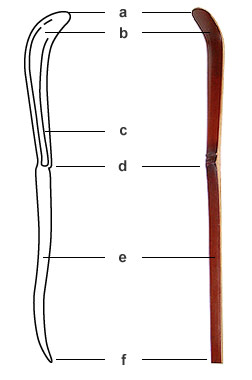
a) tsuyu 露 b) kaisaki 櫂先 c) hi
樋
d) fushi 節 e) ottori 追取 f) kiridome 切止 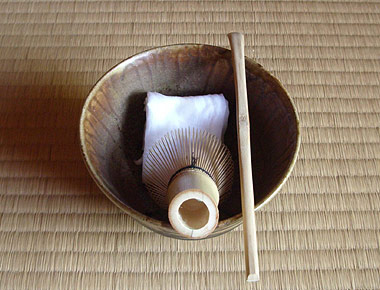 |
||||||||||||||||||||
| chakin 茶巾 | ||||||||||||||||||||
| A small napkin used at a tea ceremony for wiping the tea bowl. Generally it is made from a linen cloth 30cm long x 12.5cm wide, with the top and bottom edges having a half centimeter sewn border, reducing it to 11.5cm wide. When in use, the chakin is folded lengthwise into thirds. Then, the long edge is folded in half and puffed up before it is folded again in half. Finally, its edges are folded a little to adjust the shape. | ||||||||||||||||||||
| Wabi わび | ||||||||||||||||||||
|
Also written 侘 or 佗. An aesthetic ideal that finds surpassing beauty and deep
significance in what is humble or commonplace and appears natural or artless.
This conception of beauty as simple and austere is found in poetry, and came to
be the dominant philosophy in the practice of tea or chanoyu
茶湯, often called wabicha 侘茶 or "wabi style tea." Deriving
from the verb wabu わぶ "to languish" and the adjective wabishi
わびし "spiritual loneliness," wabi was used first in early poetry
to decribe the "despair of a forlorn lover" and later came to denote
the barren circumstances of the poet-recluse, it was not truly influential until
it was absorbed into the ideal of sabi さび. The originally negative connotations
changed with the development particularly under Zen Buddhist influences of a positive
view of seclusion from the mundane in the locus of the hermit's hut. In much literature
of the early medieval period we find this aesthetic of an artless beauty based
on the appreciation of the imperfect and irregular aspects of nature. Tea master Murata Jukou 村田珠光 (1423-1502) was an early exponent of wabicha who adopted literary terms such as hie 冷え, chill, and kare 枯れ, withered, to express the bleak, monochromatic appeal of the simple domestic wares he introduced into the practice tea. Students of Jukou also began holding tea gatherings in a thatched-hut souan 草庵, tea houses chashitsu 茶室, modeled on the hermit's grass hut. Takeno Jouou 武野紹鴎 (1502-55) is said to have emphasized ethical and metaphysical aspects of wabi, calling it free of arrogance. Jouou also cited Fujiwara Teika's 藤原定家 (1162-1241) waka "looking out there are neither blossoms nor crimson leaves, an old hut by the bay in evening" as conveying its essence. The integration of wabi into chanoyu was further developed by Sen Rikyuu 千利休 (1522-91) in his encouragement of the use of the smallest possible space of the two-mat thatched-hut tearoom, simple, rustic tea wares such as rakuyaki 楽焼, and the unadorned and simple forms of bamboo flower containers and other utensils. Rikyuu and his heirs sought in the tea hut the locus for a Zen-like experience of freedom from the mind. This aesthetic which finds richness in poverty, beauty in simplicity, and enlightment in artistic discipline has been termed wabisuki わび数奇, a fusion of wabi with the word suki 数奇 or aesthetic liking. Wabisuki reached its ultimate stage in the gokuwabi 極わび, "wabi in the extreme," as practiced by tea-master such as Rikyuu's grandson Sen Soutan 千宗旦 (1578-1658). The influence of the wabi aesthetic is clearly seen in chashitsu architecture, ceramics, and other arts directly connected with chanoyu. Wabi taste also played a role in the connoisseurship and collecting of older paintings and works of calligraphy. Moreover, wabi, as dominant aesthetic of late 15c and 16c, exerted an influence on contemporary painting, particularly the rough and "natural" style of soutai 草体 or "grass style" (shin gyou sou 真行草) ink painting, suibokuga 水墨画. |
||||||||||||||||||||
| Sabi さび | ||||||||||||||||||||
| Also
written 寂. 1 An idea of beauty particularly important in the tea ceremony and haiku 俳句 poetry. The beauty of materials or spaces which have been worn down over time to become withered and aged. Seen particularly in teahouses, tea utensils and tea gardens. Initially a medieval aesthetic ideal, sabi included aspects of resignation, age, decay, loneliness, detachment, and tranquility. The noun sabi derives from the verb sabu 寂ぶ "to wane" and the adjective sabishii 寂しい "lonely", and also sounds the same as the noun sabi 錆び meaning "rust" or an "aged quality." Fujiwara Shunzei 藤原俊成 (1114-1204) used sabi as a critical quality to judge in poetry, where it refered to a mood of desolation. Sabi can also be seen in the feeling of beautiful loneliness described by hermit poets such as Saigyou 西行 (1118-1190). For 15c writers such as Zeami 世阿弥 (1363-1445) and Shinkei 心敬 (1406-75), sabi became a kind of cold beauty associated with the positive qualities of kare 枯れ "withered" and hie 冷え "chill." Its presence can be detected in a range of arts during the 14 and 15c. In the late 17c, a modified interpretation of sabi was particularly important to haiku 俳句 poets it was naturally an important aspect of haiga 俳画 or haiku painting, and indirectly influenced other styles of painting related to haiku. This tendency was represented by Matsuo Bashou 松尾芭蕉 (1644-94) and others of his generation. 2 The colour acquired by rocks in a garden which have been weathered and corroded over time. In the Edo period, this coloring was sometimes artificially applied to rocks. | ||||||||||||||||||||
| Suki 数寄 | ||||||||||||||||||||
| Lit. Aesthetic liking. Most simply love for elegant things, particularly poetry (waka 和歌) and the objects of the practice of tea (chanoyu 茶湯), but, at a deeper level, a paradoxical ideal that seeks ultimately to transcend taste and aesthetics. In the Heian period suki generally referred to amorous adventure with the implication that this was an elegant accomplishment to be carried out in a refined manner. In the Kamakura period suki suggested a devotion to art, particularly poetry, and the pursuit of it with a deep sensitivity often acheived by severing ties with secular society and living as a hermit. In waka treatises such as FUKUROSOUSHI 袋草紙 (ca 1156), suki is often used to describe the extreme or eccentric behavior of waka poets devoted to their art. In the HOSSHINSHUU 法心集 of 1216, Kamo no Choumei 鴨長明 (1155-1216) describes suki as solitude, poverty, purity produced by closeness to nature, and freedom from worldly defilement as a means of realizing the impermanence of existence and thus achieving enlightenment. Devotion to artistic accomplishment became concomitant with a desire for buddhahood. Thus adoption to suki aesthetics led to detachment from mundane life and to an emphasis on the retreat/hermitage as the locus of artistic creation. This taste for "aesthetic reclusion" (suki-no-tonsei 数奇の遁世) greatly influenced the development of chanoyu. By the early 15c the term suki was applied to men of tea chasuki 茶数奇 (lit. tea enthusiast), as well as poets. Suki was also applied to specific styles or tastes within chanoyu. For example, the taste for Chinese objects (karamono 唐物) was termed karamono suki 唐物数奇, while the taste for native things was wamono suki 和物数奇. Suki was used to describe the small, thatched-hut (souan 草庵) type of tearoom. By the early 16c., the term suki alone was synonomous with chanoyu. Moreover, the ideal of suki formed the conceptual basis of the style of tea practice devoted to orderliness, simplicity, and aesthetic appreciation exemplified in the term wabiわび used by the great tea-masters Murata Jukou 村田珠光 (d.1502), Takeno Jouou 武野紹鴎 (1502-55), and Sen no Rikyuu 千利休 (1522-91). Suki also may include a sense of Buddhist compassion. The devotion to wabi style tea in the late 16c created the term wabisuki わび数奇. Tea masters were cha-no-sukisha 茶の数奇者 or simply sukisha 数寄者. Tea wares were called sukimono 数奇物. Tea architecture became sukiya 数奇屋. The word suki when used since the Edo period (around the 17c) in relation to chanoyu is usually written with the characters 数奇. (literally "fortune" and "oddness"). Two influential Edo period chanoyu treatises, NANBOUROKU 南方録 (1690) and ZENCHAROKU 禅茶録 (1826) , maintain that the older useage of suki 好 (also read konomi) meaning "to love" or "to covet" remained in the practices of treasuring favorite tea utensils. Suki has come to mean refinement tinged with eccentricity, the sukisha as someone who does not bend to wordly concerns, sukimono as assymetrical and (while appearing spontaneous) carefully contrived objects. This aspect of suki encouraged the appreciation and patronage of ceramics such as Bizen 備前, Oribe 織部 or Iga 伊賀 wares. The suki aesthetic seeks to acheive the imperfect, natural beauty of wabi through controlled imperfection called "naturalness." Thus ceramic glaze effects that appear spontaneous or simple rustic architectural finishes and decoration result from a rigorous and by the late 17c., carefully codified selection and refinement of techniques. | ||||||||||||||||||||
| Go to Cha-no-yu Return to Study Guide Email to Shibui Swords |
